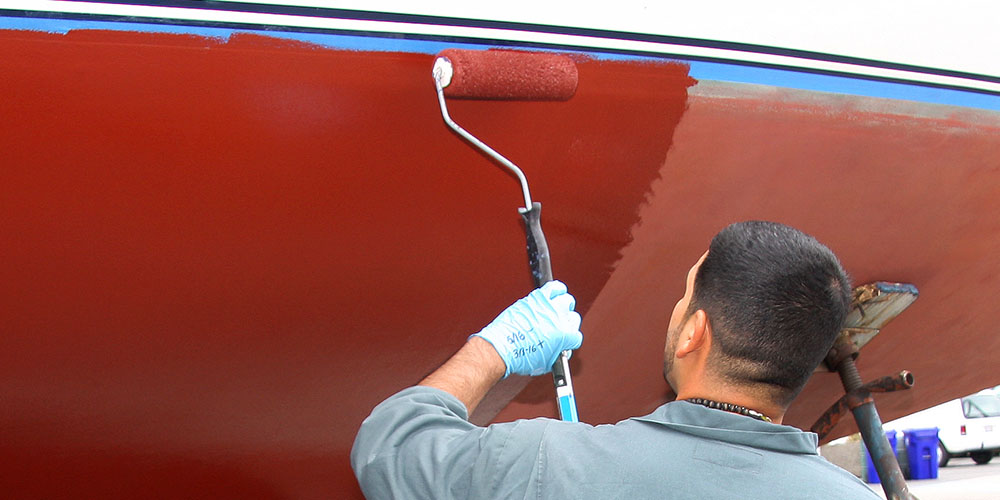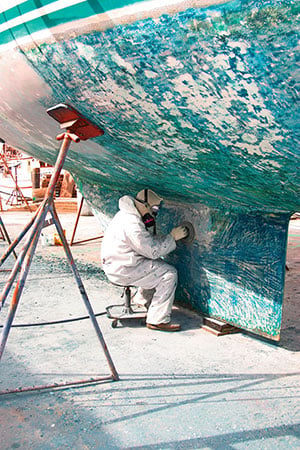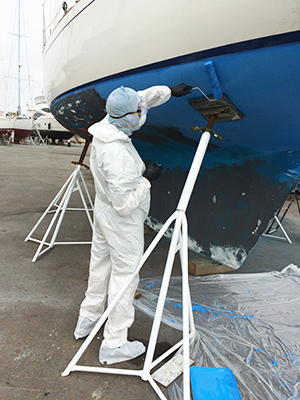

Fully outfitted in safety gear to protect against toxic antifouling paint dust.
If you store your boat in the water at least part of the year, keeping the hull free of marine growth with one or more coats of quality antifouling paint is critical to keep it performing its best—and for reducing fuel costs. This preventative maintenance task should be at the top of your list. A clean hull is safe, fast and efficient—while a fouled bottom will reduce your boat's speed, maneuverability and cost you more at the fuel dock. We'll give you a quick rundown on what antifouling paint does and 10 questions to ask yourself before buying.
- What Antifouling Paint Does
- Are You Painting Over an Aluminum Hull or Sterndrive?
- Do You Want Bright Colors?
- Are You In an Area that Restricts Copper Biocides?
- Do You Want to Use a Water Based Paint?
- Do You Want to Haul Out Over the Winter and Relaunch Without Repainting?
- Are You Going to Be Using a Vinyl-Based Paint?
- Do You Boat in Saltwater or Freshwater?
- How Often Do You Use Your Boat?
- Do You Store Your Boat Out of the Water When You're Not Using It?
- Are You Painting Over Old Paint?
- Painting Guides with Color Charts
What Antifouling Paint Does
Antifouling paint prevents marine organisms such as barnacles and zebra mussels, weeds, slime and algae from attaching themselves to the hull. Most antifouling paints use the dissipation of metal as a toxic biocide (on the hull’s surface and adjacent to the hull in the water) to prevent biofouling. Previously, hulls of sailing ships were covered with solid copper sheathing below the waterline. Today, copper in the form of cuprous oxide or other copper compound remains the principal biocide mixed into antifouling paints to prevent marine growth.
Antifouling paint choices tend to be regional, with boaters in the Great Lake\s, Pacific Coast, Southeast, Gulf Coast and other areas choosing similarly to their neighbors in the local marina. Using the same paint as your neighbor might work well for you, however you should also consider how you use your boat and the type of paint you applied in the past, since there can be compatibility problems between different formulations. In general, softer paints can be applied over harder paints but not vice-versa; vinyl paints should only be applied over vinyl paints. There are exceptions however, so it’s always best to consult a compatibility chart.
1. Are You Painting Over an Aluminum Hull or Sterndrive?
Never apply an antifouling paint that contains cuprous oxide on an aluminum hull or outdrive. Doing so will result in galvanic corrosion that will damage or even destroy the hull. Instead, select an antifouling paint that contains a compound of zinc, cuprous thiocyanate, or a non-metallic agent, such as ECONEA™ as the biocide. Examples include Vivid (cuprous thiocyanate), Trilux 33 (cuprous thiocyanate) and Hydrocoat ECO (ECONEA).

Applying Hydrocoat ECO to a Cal 40. I am not wearing an organic vapor respirator. This ECONEA-based paint has virtually no smell.
2. Do You Want Bright Colors?
If you want your bottom paint to really dazzle, use one that contains white copper (cuprous thiocyanate), zinc or ECONEA as the biocide. White copper is clean white in color and used in brightly colored paints such as Pettit’s Vivid and Interlux Trilux 33. White copper formulations require 50% less copper than heavier conventional antifouling paint formulated with dark cuprous oxide. White copper produces the brightest colors, whitest whites and blackest blacks. Paints that contain ECONEA as the biocide are another choice. ECONEA® is a metal-free biocide that, depending on the paint formulation, can be as effective as cuprous oxide at about one tenth the concentration in paint by weight. This results in a brighter range of colors compared to darker cuprous oxide based paints. ECONEA also does not cause discoloration in the presence of sulfides, as do metal-based paints.
3. Are You In an Area that Restricts Copper Biocides?
Your best bet here is to use a bottom paint that contains zinc or ECONEA as the biocide. Worthy of mention, is the specialty paint PropSpeed which contains no biocide at all. Instead, it is a super-slick coating that easily sheds marine growth. Propspeed is used on underwater metals, including props, struts, shafts and keel coolers.
4. Do You Want to Use a Water Based Paint?
Water based antifouling paints replace the harsh solvents found in most bottom paints with water, resulting in an easier application and clean up, with no heavy solvent smell. Our WBA paint and Pettit's Hydrocoat Eco are both good options in this category.

Storing your boat for the winter without antifouling paint is one option. Another is to apply a copolymer antifouling paint in the fall, which will eliminate the task of painting the bottom when you recommission in the spring.
5. Do You Want to Haul Out Over the Winter and Relaunch Without Repainting?
Use a copolymer ablative antifouling formulation. Copolymer paints release biocide at a constantly controlled rate throughout their lives, wearing away or “ablating” much like a bar of soap. Paint wears off faster in higher drag areas on the hull and appendages. These paints work well in high-growth areas and continue to be effective after haulout at the end of the season. In the spring, the paint is reactivated with a scrubbing or light sanding and you’re ready for another season. This is a huge time-saver for those living in northern climates. While the percentage of copper in the paint is important, it is not the only consideration. Controlled polishing, the technology that controls how quickly the paint wears away, also contributes to the effectiveness of these paints.
If you choose a copolymer paint, we recommend two or three coats on the first application. Copolymer paints with anti-slime additives are best for heavy fouling areas. Environmentally preferable Ultima ECO and Pacifica Plus are ECONEA-based copolymer ablatives.
Ablative paints (of the non-copolymer type) work in a similar way and minimize the annual ritual of sanding when applying a fresh coat. Best use is as a single-season paint for boats that are used often, but are not serviced by a diver. Not recommended when you want a super-smooth bottom finish and have a diver maintain it, since scrubbing removes paint and reduces longevity.
6. Are You Going to Be Using a Vinyl-Based Paint?
Make sure you remove the old paint film unless it’s also vinyl based.
7. Do You Boat in Saltwater or Freshwater?
Some paints are recommended for freshwater, while others are not. For example, Interlux's Micron 66, which depends on a reaction with saltwater to be effective, should not be used in freshwater. Other paints, such as Pettit's SR-21 (favored for racing boats) is best suited for freshwater or short-term use in low-fouling, cold saltwater areas.
8. How Often Do You Use Your Boat?
Frequently used boats may want to use an ablative paint, which will get smoother over time and will shed light growth. Infrequently used boats may want to use a modified epoxy paint that will have good antifouling properties when the boat is inactive.
If you keep your boat in the water year round you are most likely a candidate for a high-copper-content modified epoxy paint that prevents growth by leaching biocides upon contact with water. Contact leaching paint releases the biocide at a steadily decreasing rate, leaving the hard coating of the original thickness at season’s end. Higher copper content, rather than the type of paint binder as with ablative paints, generally means greater effective performance in this paint type. Modified epoxy paints adhere tenaciously to most surfaces and can be applied over most types of paints—except vinyl-based paints. Since hard, modified epoxy paints do not wear away, an egg shell-like buildup will occur over successive haulouts. Eventually you will need to "bite the bullet" and undergo the not-so-fun task of stripping away the paint.
9. Do You Store Your Boat Out of the Water When You're Not Using It?
Choose a copolymer paint that remains effective for and indefinite period of time. Copolymer paints, like West Marine PCA Gold, Interlux Micron Extra and Pettit Hydrocoat, offer true multi-season protection, lasting as long as there is a reasonable coating thickness. Because they expose new biocide until the coating is worn completely away, additional coats add to their longevity
10. Are You Painting Over Old Paint?
Here are three general rules:
- Make sure the old paint is firmly attached. Don’t put good paint over loose, flaky paint.
- Don’t apply paint over old paint that contains a slippery Vinyl or PTFE agent
- Don’t apply a hard paint over a soft paint.
Help for the Do-It-Yourself Painter
For more information on for the do-it-yourself boat owner on how to prep your boat’s bottom and apply antifouling paint, see our West Advisor and companion video called Do-It-Yourself: Bottom Painting.
Painting Guides with Color Charts